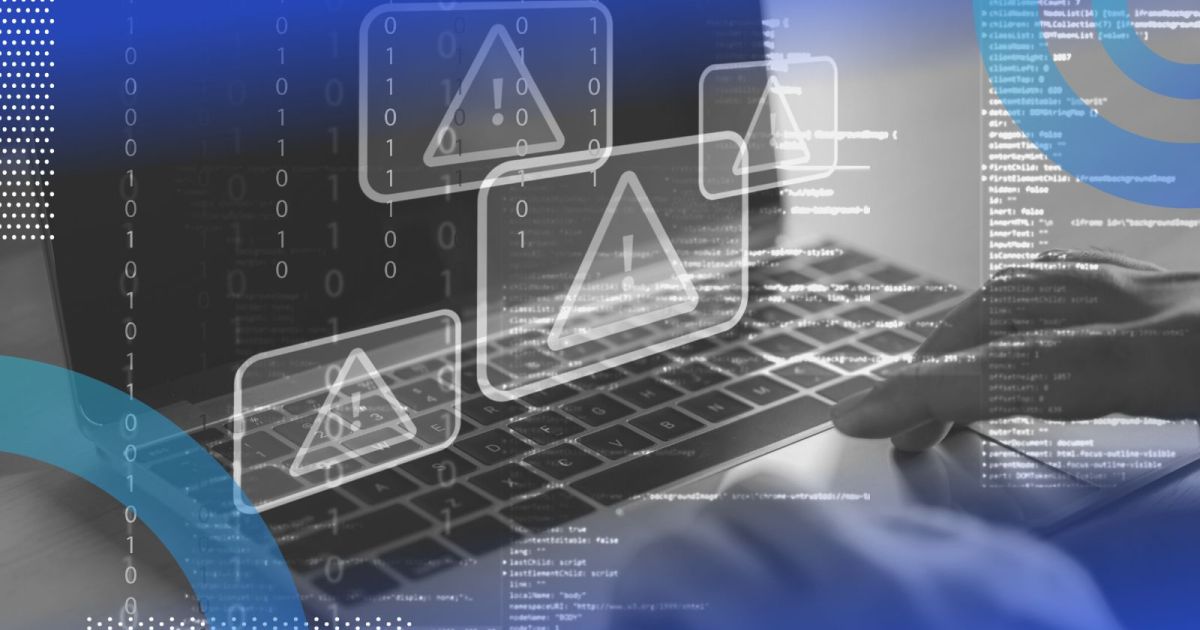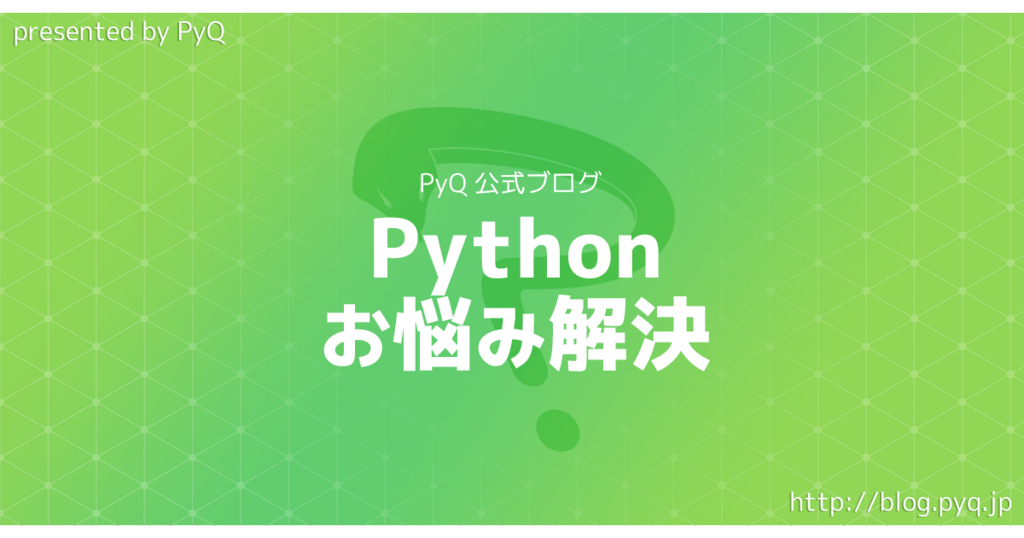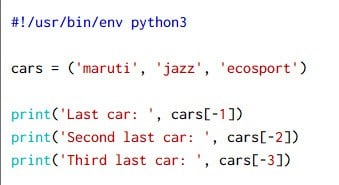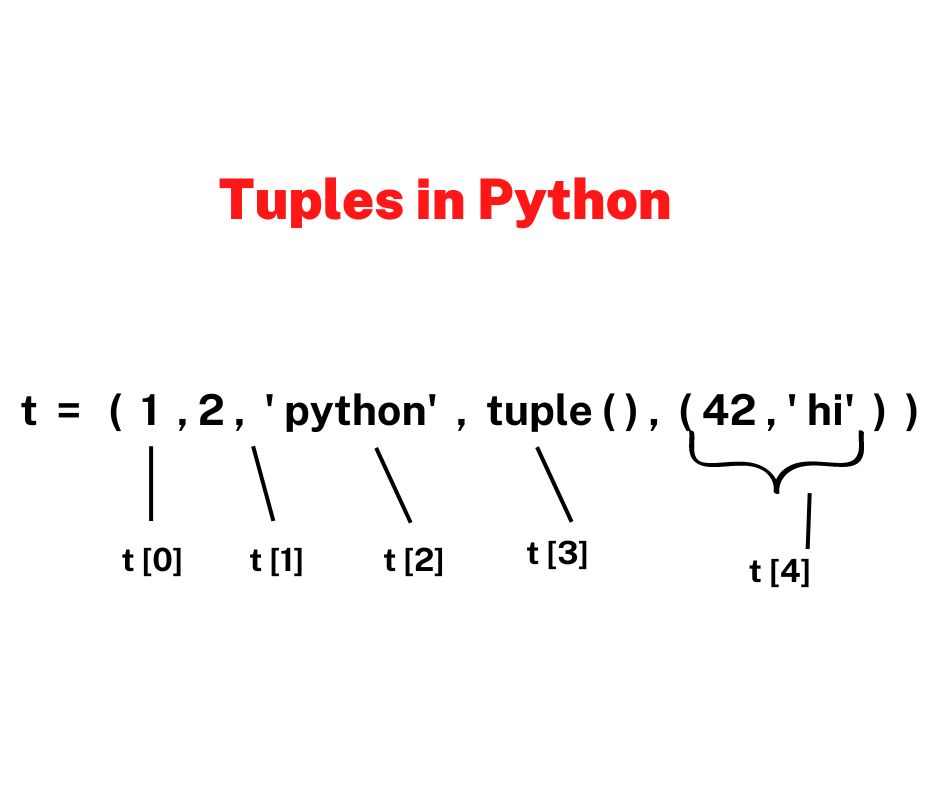Tuple Indices Must Be Integers Or Slices Not Str
Overview of Tuple Indices in Python
In Python, tuples are ordered and immutable collections of elements. They can store a variety of data types, such as numbers, strings, and even other tuples. Each element in a tuple is assigned an index, starting from zero for the first element, and incrementing by one for each subsequent element. Tuple indices allow us to access and manipulate specific elements within a tuple.
Understanding Data Structures: Tuples
Tuples are a fundamental data structure in Python and have several important characteristics. Firstly, they are immutable, meaning that once a tuple is created, its elements cannot be modified. Secondly, they are ordered, which implies that the elements are arranged in a specific sequence that can be accessed using indices. Lastly, tuples support different data types, enabling them to hold a mixture of values.
Indexing and Slicing Tuples in Python
Indexing is the process of accessing a specific element in a tuple using its position or index. Python uses a zero-based indexing system, so the first element of a tuple can be accessed using an index of 0, the second element with an index of 1, and so on. To access a specific element, we can use square brackets [ ] and provide the index value inside them.
For example, consider the tuple `fruits = (‘apple’, ‘banana’, ‘cherry’)`. We can access the element ‘apple’ by using `fruits[0]`, ‘banana’ with `fruits[1]`, and ‘cherry’ with `fruits[2]`.
Slicing is a technique that allows us to extract a portion of a tuple by specifying a range of indices. The slice notation uses a colon (:) to separate the starting and ending indices. It is important to note that the ending index is not inclusive.
For instance, using the same tuple example as before, `fruits[0:2]` would yield a new tuple (‘apple’, ‘banana’), as it includes elements at indices 0 and 1, but excludes the element at index 2.
The Importance of Using Integers or Slices as Tuple Indices
When indexing or slicing a tuple, it is vital to use either integers or slices as indices. Integers correspond to specific positions within the tuple, while slices represent ranges of indices. Using any other type, such as strings, as indices results in an error.
Common Error: “tuple indices must be integers or slices, not str”
One common error encountered while working with tuples is the message “tuple indices must be integers or slices, not str.” This error occurs when a string is mistakenly used as an index in an attempt to access a particular element within a tuple.
Explanation of the Error Message
The error message “tuple indices must be integers or slices, not str” serves as a helpful indicator that the type of index being used is incorrect. It tells us that string indices are not recognized by Python and should be replaced with either integers or slices, depending on the desired outcome.
Causes of the Error: Using a String as an Index
The primary cause of this error is mistakenly using a string as an index when attempting to access an element within a tuple. This can happen when a programmer overlooks the correct syntax for indexing and mistakenly uses a string value instead of an integer or a slice.
Examples of Incorrect Indexing and Its Consequences
Let’s take a look at a few examples of incorrect indexing and its consequences:
1. `fruits = (‘apple’, ‘banana’, ‘cherry’)`
`print(fruits[‘apple’])`
This will result in the error message mentioned earlier since ‘apple’ is being used as an index, which is a string.
2. `fruits = (‘apple’, ‘banana’, ‘cherry’)`
`print(fruits[4])`
Trying to access an element at index 4 in the tuple ‘fruits’ will again trigger the error because the index is out of range.
How to Avoid the Error: Using Valid Indices
To avoid the error “tuple indices must be integers or slices, not str,” it is essential to use valid indices, which are either integers or slices. When accessing a specific element, ensure the index corresponds to a valid position within the tuple. If using slicing, double-check that the starting and ending indices are within the tuple’s range. By strictly adhering to these rules, you can prevent the error from occurring.
Best Practices for Indexing and Slicing Tuples
To index and slice tuples effectively, consider these best practices:
1. Use Integers or Slices: Always use integers or slices when indexing or slicing a tuple. This ensures compatibility with Python’s indexing system and avoids any potential errors.
2. Check Index Boundaries: When using integers, verify that the index falls within the appropriate range of the tuple. Trying to access an element outside its boundaries will result in an error.
FAQs:
Q: What other data structures exhibit similar indexing behavior?
A: Similar indexing behavior can be found in lists and strings. However, the error message may differ depending on the data structure.
Q: Can we use variables as tuple indices?
A: Yes, variables can be used as tuple indices as long as they hold valid integers or slices.
Q: Can we modify a tuple’s element using indexing?
A: No, tuples are immutable, meaning their elements cannot be modified once created.
Typeerror: Tuple Indices Must Be Integers Or Slices, Not Str
What Does Tuple Indices Must Be Integers Or Slices Not Float?
When working with tuples in Python, it is essential to understand the concept of indexing. Tuples are immutable sequences, meaning their elements cannot be modified once created. You can access specific elements of a tuple using indices, which are integers representing the position of an item within the tuple. However, it is important to note that tuple indices must always be integers or slices, and not float values.
To grasp the reasoning behind this limitation, we need to delve into the nature of float numbers and their representation in computers. Float numbers are stored using a different system compared to integers. While integers can be represented precisely, floats are subject to rounding errors due to their binary representation.
Python, like many other programming languages, adheres to a strict typing system. This means that certain operations and data types cannot be mixed unless explicitly supported by the language. When you attempt to use a float as an index value for a tuple, Python raises a “TypeError” exception with the message, “tuple indices must be integers or slices, not float.”
Float numbers are not allowed as indices for tuples because they are not consistent with the underlying structure and behavior of tuples. Tuples are implemented as arrays, and when accessing elements using indices, the operation involves directly accessing the memory location where the desired item is stored. Since float numbers can have precision issues, they are unreliable for indexing. To ensure consistency, Python restricts the usage of float values for tuple indices.
Additionally, using floats as indices would lead to ambiguity. Tuples are sequences, and each element is identified by its position within the sequence. Using floats as indices would introduce uncertainty about which element is being referred to. For example, if you have a tuple with five elements [0, 1, 2, 3, 4], using a float index like 2.5 would create confusion about whether it refers to index 2 or index 3. By enforcing integer or slice indices, Python ensures clarity and unambiguous access to tuple elements.
FAQs
Q: What is the difference between integers and floats?
A: In Python, integers are whole numbers without a decimal point, while floats are numbers with fractional parts.
Q: Can I convert a float to an integer for tuple indexing?
A: Yes, you can explicitly convert a float to an integer using built-in functions like “int()” or by using integer casting such as “int(my_float)”.
Q: Are float indices allowed in other data structures, like lists or arrays?
A: No, float indices are not allowed in any sequence-based data structures in Python, including lists and arrays.
Q: What are slice indices?
A: Slice indices are a way to specify a range of values within a sequence. They are denoted by “start:end” and can be used in tuples, lists, or other sequence types.
Q: Are there any alternatives to using float indices with tuples?
A: If you need to access elements within a tuple based on a floating-point value, you can convert the tuple to a list, perform the necessary computations to obtain the desired index as an integer, and then access the element using that index.
Q: Can I modify a tuple using slice indices?
A: No, tuples are immutable, meaning their elements cannot be modified. Slice indices are used to obtain a new tuple with a subset of the original elements.
In conclusion, tuples in Python are indexed using integers or slices, and not floats. This restriction is in place to maintain consistency, clarity, and reliability when accessing tuple elements. Float numbers introduce precision issues and ambiguity, making them unsuitable for indexing. By understanding this limitation, you can effectively work with tuples and ensure proper usage of indices in your Python programs.
What Does List Indices Must Be Integers Or Slices Not Tuple?
If you are a Python programmer, you may have come across the error message, “List indices must be integers or slices, not tuple.” This error typically occurs when you are trying to access or manipulate elements in a list using incorrect syntax. In this article, we will explore the meaning behind this error message, why it occurs, and how to avoid it. Additionally, we will address some frequently asked questions related to this topic.
Understanding List Indices:
Before diving into the error message itself, it’s crucial to comprehend what list indices are in Python. A list is a collection of items enclosed within square brackets and separated by commas. Each element in a list is assigned a unique index value, which allows for easy access and modification of individual elements. The indexing of a list starts from 0, meaning the first element has an index of 0, the second element has an index of 1, and so on.
For example, consider the following list:
fruits = [“apple”, “banana”, “orange”]
In this case, “apple” has an index of 0, “banana” has an index of 1, and “orange” has an index of 2.
Understanding the Error Message:
When you encounter the error message “List indices must be integers or slices, not tuple,” it signifies that you are using parentheses instead of square brackets to access or modify an element in a list. In Python, parentheses are used to define tuples, which are similar to lists but are immutable, meaning their elements cannot be changed once defined.
To avoid this error, you need to ensure that you are using square brackets to access or modify elements in a list.
Common Causes of the Error:
There are several common causes that can trigger this error message. Let’s go through them one by one:
1. Accidentally using parentheses instead of square brackets: This is the straightforward case where you mistakenly use parentheses instead of square brackets when attempting to access or modify an element. For instance:
fruits = [“apple”, “banana”, “orange”]
print(fruits(1)) # Incorrect
print(fruits[1]) # Correct
2. Using a tuple as an index: In some cases, you might unintentionally pass a tuple as an index value instead of an integer or slice. For example:
fruits = [“apple”, “banana”, “orange”]
index = (1,)
print(fruits[index]) # Incorrect
print(fruits[index[0]]) # Correct
In the above example, the tuple (1,) is used as an index, resulting in the error message. To rectify this, you need to convert the tuple into an integer by accessing its first (and in this case, only) element.
3. Mistakenly using a colon within parentheses: A syntax error could also lead to the mentioned error message. If you mistakenly use a colon within parentheses instead of square brackets, the interpreter will interpret it as a tuple and raise an error. For instance:
fruits = [“apple”, “banana”, “orange”]
slice = (1:2)
print(fruits[slice]) # Incorrect
print(fruits[slice[0]:slice[1]]) # Correct
In this example, the colon inside parentheses caused the error. By placing it within square brackets and accessing the corresponding elements, you can rectify this error.
Frequently Asked Questions (FAQs):
Q: Can I use any data type as a list index in Python?
A: No, list indices in Python must be integers or slices. Other data types, such as float or string, will lead to a different error message.
Q: Is it possible to use negative indices in Python lists?
A: Yes, Python allows the use of negative indices to access elements from the end of a list. For example, -1 refers to the last element, -2 refers to the second-to-last element, and so on.
Q: Can I use a tuple as an index in a multidimensional list?
A: Yes, tuples can be used as indices for multidimensional lists. Each element within the tuple corresponds to the index of the corresponding dimension. However, it’s essential to use square brackets instead of parentheses when accessing elements.
Q: How can I avoid encountering this error?
A: To avoid this error, always use square brackets instead of parentheses when accessing or modifying elements in a list. Double-check your syntax to ensure correctness.
Q: Is there a way to convert a tuple into an integer directly?
A: To convert a tuple into an integer, you can access the first (and possibly only) element of the tuple. Since indexing returns the element itself, you effectively convert the tuple into an integer.
Keywords searched by users: tuple indices must be integers or slices not str Tuple indices must be integers or slices not str iterrows, List indices must be integers or slices, not str, Tuple indices must be integers or slices, not list, String indices must be integers, List indices must be integers or slices, not dict, Tuple in Python, List tuple to dict Python, Convert tuple to dict Python
Categories: Top 74 Tuple Indices Must Be Integers Or Slices Not Str
See more here: nhanvietluanvan.com
Tuple Indices Must Be Integers Or Slices Not Str Iterrows
Python is a versatile programming language widely used for data manipulation and analysis. One of the powerful tools in the Python ecosystem is the pandas library, which provides flexible and efficient methods for handling large datasets. When working with pandas DataFrames, it is crucial to understand the importance of using proper indexing techniques. In particular, the concept of tuple indices being limited to integers or slices, not string iterrows, is a crucial aspect to comprehend.
In pandas, the DataFrame object consists of rows and columns, with each row representing a specific observation or sample, and each column representing a particular variable or feature. Indexing plays a crucial role in accessing and retrieving data from DataFrames. The tuple indices refer to the values used to select specific rows or columns in a DataFrame. However, one common mistake made by beginners is attempting to use string iterrows as tuple indices, which can lead to errors and unexpected results.
The iterrows() function in pandas is a convenient method to iterate over a DataFrame row by row. It returns an iterator yielding index and row data as a Series. While iterating over a DataFrame using iterrows() can be helpful for certain tasks, it is not suitable for indexing purposes. This is because the indices returned by iterrows() are strings containing the column names, which do not conform to the required integer or slice format for tuple indices.
When attempting to access data from a DataFrame, it is essential to use the iloc or loc accessor methods, which respect the integer/slice index requirement. The iloc method allows indexing by integers, while the loc method enables indexing by values in the DataFrame’s index or column names. Both methods provide a flexible and efficient way to extract data based on specific criteria.
Using an incorrect indexing method, such as string iterrows, can lead to a variety of errors. One common error that may occur is a “TypeError: tuple indices must be integers or slices, not str” message, indicating the violation of indexing rules. This error typically arises when trying to access specific rows or columns using inappropriate indexing techniques, like passing string iterrows as indices, contrary to the expected integer or slice patterns.
To avoid such errors, it is crucial to understand and adhere to the correct indexing conventions. When using the iloc method, indexing is performed purely based on integer positions. For example, df.iloc[0] returns the first row of the DataFrame, df.iloc[:, 0] returns the first column, and df.iloc[0:5, 1:3] returns a subset of rows (0 to 4) and columns (1 to 2). Here, the colon (:) represents all possible values for rows or columns within the specified range.
On the other hand, the loc method allows indexing based on label values from the DataFrame’s index or column names. For instance, df.loc[‘index_label’] returns the row corresponding to the provided index label, while df.loc[:, ‘column_name’] returns a specific column based on its name. Similarly, df.loc[‘index1′:’index5’, ‘column1′:’column3’] retrieves a subset of rows and columns using label-based indexing.
It is important to note that string iterrows cannot be used as indices in either the iloc or loc methods. Instead, they can be used solely for iterative purposes when iterating over a DataFrame row by row. To iterate over rows with the iterrows() function, one can use a for loop as follows:
“`
for index, row in df.iterrows():
# Perform operations on each row
“`
The FAQ section below addresses common queries related to tuple indices, string iterrows, and appropriate indexing techniques in pandas:
Q1: Why can’t I use string iterrows as tuple indices?
A1: Tuple indices in pandas DataFrames must be integers or slices to follow the indexing conventions. String iterrows, returned by the iterrows() function, represent the column names of the DataFrame and do not adhere to the required indexing format.
Q2: What is the purpose of the iloc and loc methods?
A2: The iloc method allows indexing by integer positions, while the loc method enables indexing based on label values from the DataFrame’s index or column names. They provide efficient ways to extract specific data from DataFrames based on criteria.
Q3: How can I resolve the “TypeError: tuple indices must be integers or slices, not str” error?
A3: To resolve this error, review the indexing technique used and ensure that string iterrows are not used as tuple indices. Instead, use either the iloc or loc methods for proper indexing.
Q4: Can I use string iterrows for any indexing tasks?
A4: No, string iterrows are not suitable for indexing purposes. They can only be used for iterating over a DataFrame row by row, primarily within a for loop.
Q5: Are there any alternative methods to string iterrows for iterating over a DataFrame?
A5: Yes, apart from string iterrows, the itertuples() function can be used for iterating over a DataFrame in a more efficient manner.
In conclusion, when working with pandas DataFrames, it is essential to understand the limitations of tuple indices. While string iterrows obtained through the iterrows() function can be useful for iteration purposes, they cannot be used as indices. Adhering to proper indexing techniques, such as using iloc or loc methods, ensures accurate data extraction and avoids errors caused by inappropriate indexing.
List Indices Must Be Integers Or Slices, Not Str
When working with lists in Python, you may come across an error message that says “list indices must be integers or slices, not str.” This error can be frustrating, especially for beginners, but understanding its cause and how to fix it is essential for smooth programming. In this article, we will delve into what this error means, why it is raised, and explore common scenarios where it may occur. We will discuss potential solutions and provide helpful tips to avoid this error in the future.
What does the error “list indices must be integers or slices, not str” mean?
In Python, lists are ordered collections of items that can be accessed using indices. Indices allow you to refer to specific elements within a list, starting from 0 for the first element. When you attempt to access an element using an index, Python expects the index to be an integer or a slice, which is a consecutive range of indices. However, if you provide a string as an index instead of an integer or a slice, this error is raised.
Why does the error occur?
The error “list indices must be integers or slices, not str” occurs when you use a string as an index while attempting to access an element in a list. Python treats lists as sequences of elements, and it does not allow direct access using a string. Unlike dictionaries where strings can be used as keys, lists can only be accessed by integer indices or slices. Thus, if you mistakenly pass a string as the index, Python cannot identify the element you are trying to access, leading to this error.
Common scenarios where this error occurs:
1. Accessing list elements using a string:
“`
my_list = [1, 2, 3, 4, 5]
print(my_list[‘index’]) # Raises “list indices must be integers or slices, not str”
“`
In this case, attempting to access the element of `my_list` using a string as an index causes the error. To fix this, you need to provide an integer index or a slice that represents a range of indices.
2. Mistakenly converting an integer index to a string:
“`
my_list = [1, 2, 3, 4, 5]
index = 2
print(my_list[index]) # Outputs 3
print(my_list[str(index)]) # Raises “list indices must be integers or slices, not str”
“`
In this example, when the integer index is converted to a string (`str(index)`), the error is raised. To resolve this, you should avoid converting the integer index to a string before accessing the list element.
How to fix the “list indices must be integers or slices, not str” error:
1. Ensure that you are using an integer or a valid slice as the index: Double-check that the index you are using to access the list element is indeed an integer or a slice. If you accidentally use a string, revise your code accordingly.
2. Avoid converting integer indices to strings unnecessarily: Be cautious when working with variables that contain integer indices before using them to access list elements. Converting them to strings unintentionally can trigger this error.
3. Review your code for potential causes: If you encounter the error while performing more complex operations on lists, carefully inspect the relevant parts of your code. Look for any instances where a string may have been used as an index when it should be an integer or a slice.
Frequently Asked Questions (FAQs):
Q: Can list indices ever be strings?
A: No, in Python, list indices must always be integers or slices, never strings. Unlike dictionaries, where strings can be used as keys, lists do not support string indices for direct access.
Q: Why do slices work but not strings as indices for list access?
A: Slices in Python represent a range of consecutive indices. When you use a slice as an index for a list, Python understands that you intend to access multiple elements. In contrast, a string index does not provide the necessary information for Python to identify a specific element in the list.
Q: Are there any scenarios where this error does not occur?
A: This error is specific to list indexing. Other data structures like dictionaries or sets may utilize strings as keys or indices, depending on their implementation.
In conclusion, the error message “list indices must be integers or slices, not str” may initially seem intimidating, but it arises from using strings instead of integers or slices for list indexing. By understanding the cause of this error, reviewing common scenarios where it may occur, and following the suggested solutions, you can confidently tackle this issue in your Python programs. Remember, always ensure your list indices are integers or slices to avoid encountering this error.
Tuple Indices Must Be Integers Or Slices, Not List
Introduction:
When working with tuples in Python, it is important to understand how to access elements within them using indices. The syntax for accessing elements in a tuple is straightforward, but sometimes errors can occur when using the wrong type of index. One common mistake is attempting to use a list type index instead of the required integer or slice type index. In this article, we will delve into the reasons behind this restriction, the correct usage of tuple indices, and provide some frequently asked questions to help clarify any confusion.
Understanding Tuple Indices:
In Python, tuples are an ordered collection of elements enclosed within parentheses. Each element in a tuple is assigned an index, allowing for easy retrieval and manipulation. Tuple indices start at 0 for the first element, and they continue sequentially for each subsequent element.
To access a specific element within a tuple, we typically use square brackets after the tuple name, followed by the desired index. For example, given a tuple `my_tuple = (2, 4, 6, 8)`, we can access the second element by writing `my_tuple[1]` which will yield the value 4.
Why Only Integers or Slices?
The reason why tuple indices must be integers or slices, and not lists, lies in the fundamental difference between these data types. An integer represents a single, specific position within the tuple, identifying a particular element. On the other hand, a list represents multiple positions within the tuple, defining a range of elements.
By allowing only integers or slices as tuple indices, Python ensures clarity and consistency in indexing operations. When we use an integer index, Python returns a single element. But if we use a slice index, denoted by colon(s), Python returns a new tuple containing the selected range of elements. This uniformity simplifies coding and avoids ambiguity in tuple indexing.
Incorrect Usage: Using a List as an Index
Let’s consider an example to illustrate the incorrect usage of using a list as a tuple index:
“`
my_tuple = (1, 3, 5, 7, 9)
index = [0, 2, 4]
print(my_tuple[index])
“`
If we run this code, we encounter a “TypeError” with the message “tuple indices must be integers or slices, not list.”
This error occurs because we are trying to access tuple elements using a list `index`. Python expects an integer or a slice object for indexing, not a list. The solution is to use the individual list elements as separate indices or convert the list into a slice object.
Correct Usage: Individual Integers or Slices as Indices
To fix the issue, we can modify the code as follows:
“`
my_tuple = (1, 3, 5, 7, 9)
index = [0, 2, 4]
new_tuple = tuple(my_tuple[i] for i in index)
print(new_tuple)
“`
By using a list comprehension, we iterate over each element of the `index` list, treating them as separate indices. We then create a new tuple named `new_tuple` containing the desired elements.
FAQs:
Q1. Can I use variables as indices in a tuple?
Yes, you can use variables, including integers or slice objects, as indices in a tuple. However, ensure that the variables hold integer or slice values and not lists.
Q2. Can I modify elements within a tuple using indices?
No, tuples are immutable in Python, meaning you cannot change or modify their elements directly. If you want to modify a tuple, you need to create a new tuple with the desired changes.
Q3. Why can I use slices as indices, but not lists?
Slices allow you to retrieve a range of elements, making them a convenient and consistent way to access multiple elements at once. Lists, on the other hand, can represent arbitrary sequences of elements and can lead to ambiguity when used as indices.
Q4. Are there any other ways to access tuple elements besides indexing?
Yes, aside from indexing, you can also use unpacking to assign tuple elements to separate variables. For example, `a, b, c = my_tuple` assigns the corresponding elements of `my_tuple` to variables `a`, `b`, and `c`.
Conclusion:
Tuple indices in Python must be integers or slices, not lists, to ensure clarity and consistency in code. While it may seem restrictive at first, this limitation avoids ambiguity and simplifies tuple indexing operations. By understanding the correct usage of tuple indices, you can avoid errors and efficiently access elements within tuples.
Images related to the topic tuple indices must be integers or slices not str

Found 25 images related to tuple indices must be integers or slices not str theme















![typeerror: '_io.textiowrapper' object is not subscriptable [SOLVED] Typeerror: '_Io.Textiowrapper' Object Is Not Subscriptable [Solved]](https://itsourcecode.com/wp-content/uploads/2023/04/typeerror-_io.textiowrapper-object-is-not-subscriptable.png)



























![Solved][Python3] TypeError: tuple indices must be integers, not str Solved][Python3] Typeerror: Tuple Indices Must Be Integers, Not Str](https://img1.daumcdn.net/thumb/C176x176/?fname=https://blog.kakaocdn.net/dn/csMfjQ/btqKuGC0kVN/3SAZDn8Fn0ydnGgocCsquK/img.png)

Article link: tuple indices must be integers or slices not str.
Learn more about the topic tuple indices must be integers or slices not str.
- TypeError: tuple indices must be integers, not str
- typeerror tuple indices must be integers or slices not str
- tuple indices must be integers or slices, not str – Python-forum.io
- TypeError: tuple indices must be integers, not str – Codecademy
- Python pandas TypeError tuple indices must be integers or …
- Python TypeError: list indices must be integers or slices, not float Solution
- TypeError: list indices must be integers or slices, not tuple
- Python TypeError: list indices must be integers, not tuple Solution
- Fix TypeError: list indices must be integers or slices, not str – Codedamn
See more: nhanvietluanvan.com/luat-hoc